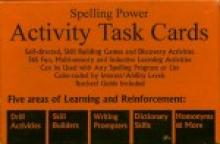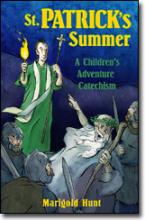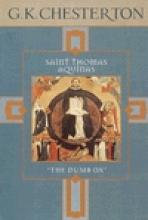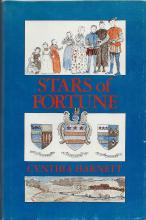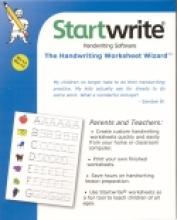No name
Spelling Power Activity Task Cards
The Spelling Power Activity Task Cards provide a multi-sensory approach to spelling instruction. (The activity cards are coded to indicate a visual, auditory, kinetic, and/or tactile instruction style.) Such an approach gives a child multiple ways to "retrieve" the phonics rules from his "mental filing cabinet." This approach is particularly well suited for children who have trouble retaining their spelling lessons, or have learning disabilities.
Though designed to accompany Spelling Power, this program can be used with any spelling textbook or list. Providing 365 activities, it is meant as a supplement for reinforcement, rather than as a complete spelling program. Most activities take only 5 or 10 minutes, though some children will want to take more time with the game or craft cards, and require little preparation from the parent. A few of the activities are designed to be done on successive days. They are also designed to be used by an individual child, but can be easily adjusted to be worked with a partner or by a group.
The activities are broken down into five categories: Drill Activities, Skill Builders, Writing Prompters, Dictionary Skills, and Homonyms & More. The activities are well-organized so that my children are able to work the program on their own with little help from me. Each activity is printed on a 3 by 5 card and color coded by ability level. A sturdy cardboard holder keeps the cards in order. A small teacher's manual is provided, which includes teaching tips and answers.
As my children complete the activities, I have them put a sticker on the back of the card. This gives them a feeling of accomplishment, especially when they go back through the cards to see how much they have done so far in a school year. Because there is such an abundance of activities, it is not necessary to do each and every activity. I let my children pick and choose their activity for a particular day. Since it is used as a supplement, I don't see any reason to be rigid in implementing the activity task cards. Instead, make it fun and introduce it to your children as a game to be played.
Teacher's Manual included
Spiritual Bouquet Card Kit from Illuminated Ink
St Monica: Model of Christian Mothers
The author, F.A. Forbes, was a nun who converted to Catholicism at the age of 31 and joined a contemplative order. She wrote several other saints' books. This is a short book, and told simply enough so that an 11-year-old could read it, though I would think a slightly older child would get more out of the book. Patricius' infidelity and Augustine's sins of the flesh are referred to only in the most general terms. Included are several prayers to St. Monica, including a litany and a novena.
It could be read as part of a historical study of the early Church or as a devotional reading. It would also be a good book for mothers to turn to when they are weary of the inevitable frustrations of being a wife and mother - and daughter in law! St Monica's perseverance and continual turning to God for strength make her, indeed, the model of Christian mothers.
Suitable for ages 11 and up.
St. Patrick's Summer
- explanations that really make sense to kids -- and adults
- Michael and Cecelia are hilariously true-to-life
- the saints are wonderful characters, full of gentle humor and fun -- people I would love to have for my friends.
- The fate of babies who die unbaptized (ch. 5, pp. 81-2) is presented as definitely lower than that of baptized infants. However, the CCC says (m. 1261):
As regards children who have died without Baptism, the Church can only entrust them to the mercy of God, as she does in her funeral rites for them. Indeed, the great mercy of God who desires that all men should be saved, and Jesus' tenderness toward children which caused him to say: "Let the children come to me, do not hinder them,"63 allow us to hope that there is a way of salvation for children who have died without Baptism. All the more urgent is the Church's call not to prevent little children coming to Christ through the gift of holy Baptism.
- In the story (also in ch. 5) St Patrick tells the children that the "Supernatural Life" that men from Adam to Jesus had access to was the same as the sanctifying grace of Baptism that we have access to in and through Christ. Whether faith in a future Messiah by those who lived before Christ's passion and death resulted in the same sort of grace as that which results from Baptism now is not clear, and a very difficult matter to understand. To treat it as if it were answered in such a simple fashion is to distort the truth. Such an assertion does not belong in a children's book; it's at best a source of great confusion and could well be false.
Original copyright 1950
Maria Rioux contributed to this review.
St. Thomas Aquinas
It does not seem adequate to compare it to a TV show but it reminds me of one of those really good PBS documentaries that gets you totally involved in something you didn't ever think was that big a deal.
Chesterton uses these different angles on Thomas and Thomism to leave you in admiration. Here was a man who by his diligence, incredible intelligence and humble love of the Truth contributed clarity to Catholic teaching - and to the WORLD (physical and spiritual). Wielding Aristotle's long forgotten philosophy Thomas makes sense of the World and the Church in a way that is profoundly true and incredibly accessible. Chesterton gives us enough of a taste to seriously whet the appetite and provides enough momentum to carry us past this book right into Thomas himself. Which is perfect. Thomas Aquinas, despite his genius (probably BECAUSE of his genius) can be understood by anyone who can read even this simple book of Chesterton's.
As Thomas was not only brilliant but humble it is fitting that Chesterton imitates the saint in this work by being both insightful and modest. Since, thankfully, Chesterton's prose is both more lucid and more delighful than my own I will defer to Chesterton's own introduction: "This book makes no pretence to be anything but a popular sketch of a great historical character who ought to be more popular. Its aim will be achieved if it leads those who have hardly even heard of St. Thomas Aquinas to read about him in better books." I would go further and suggest the reading of St. Thomas's OWN books - you will be amazed how enlightening, straighforward and refreshing it can be.
Stars of Fortune
This story is set in England in the mid 1500s and told from a Catholic perspective. As explained in the postscript, this book is the author's recreation of a legend surrounding the home belonging to the Washington family (who claims our first president as a descendant). According to the legend, Elizabeth I was once hidden in the house while fleeing pursuers. The story takes place during the tumultuous reign of Mary I (Mary Tudor, eldest offspring of Henry VIII) at which time the "old religion" has been reinstated. This is a rather subtle backdrop – one of the children notices that their housekeeper – who was a nun in hiding – cried for joy all through the Mass; their father is rebuilding parts of the house to which he secretly adds a small hiding place – presumably for priests in hiding. Some of the older boys have "romantic" notions of trying to rescue the princess and all sorts of adventures ensue. An enjoyable story in itself, it provides much substance for discussion as well.
Starting with Shakespeare
Unit Study-loving families may find in Starting with Shakespeare a very useful resource! This book is literary filled with Shakespeare-related activities! In the introduction we get to know the authors and their passionate belief in the benefits of bringing Shakespeare to elementary school. They are quite convincing with a top 20 reasons list, secrets for success and even some criticism of how memorization has been dropped from school curricula a long time ago. The introduction also helps the reader understand how the book is organized and what to expect. The first part of the book is entitled "Setting the Stage" and it offers biographical sketches on Shakespeare, very detailed ways to get the students interested, and creative tips for success. The second part presents four William Shakespeare plays, "A Midsummer Night's Dream," "Macbeth," "Hamlet," and "Romeo and Juliet" introduced for kids in a unique way alongside a plethora of resources and ideas for each one. As the publisher states: "a complete historical background, an introduction to the characters, a retelling of the story, a variety of integrated activities, verses for memorization, a complete script for class performance, and a list of resources accompany each play. Activities extend learning to history, geography, science, art, music, movement, math, and language arts." Each play is explained, character by character, plot, themes, and then told to children in prose with points for discussion in class. The authors encourage the making of a class film or video, as opposed to a performance, stating that it is simpler to use a video camera than setting up a live performance. What I enjoy about this book is that, albeit geared towards elementary school aged kids, it makes plenty of use of genuine Shakespeare language. Each play is also presented in "Will's Words--Selections for recitation", where key excerpts of the play are quoted on top of the page. Obscure words are defined and explained right below under "Say what?", and then a paragraph explains what is going on in plain English under "Kispeak". The illustrations are all made by elementary school students and some of them are quite interesting. All in all this book can be a wealth of resources for homeschool families daring the tackle the Bard of Avon in elementary or middle (or even high) school!
Startwrite Handwriting Software
System Requirements: 16 MB Ram, 20 MB Hard Disk
This is an elegantly simple computer program that resides on your hard drive just like an ordinary word processor. It allows parents and teachers to print out handwriting pages in a variety of handwriting styles, sizes and fonts. Some of your options include:
- a center dotted line
- solid text, dotted text, dashed text or text with arrows showing the proper writing direction
- how dark you want the writing printed
- a variety of fonts including standard print, italic and cursive
- Landscape or Portrait orientation
- how large you want the text to be
Please note that the user agreement allows for use on just one computer. They do offer package deals for multiple computers. You can see more about this product at http://www.startwrite.com
CD ROM for Windows 95 & above / Mac OS 8.1 & above
Stations of the Cross for Children
This small booklet can make a nice resource for a child during Stations of the Cross devotions.
Each set of double pages depicts a full page illustration in a simplified iconic format and a page of text. Under the title of each station, in bold, is the traditional prayer of the Church: We adore you, o Christ and we praise you, because by your Holy Cross you have redeemed the world. The language is directed towards children, and it has a personal and sincere tone. In a letter format, each opens with a Dear Jesus greeting and ends with an Amen. Subjects revolve around the everyday life of a child and the prayers are very nicely worded. See the sample page below. This is a very nice resource, especially for Lent.

